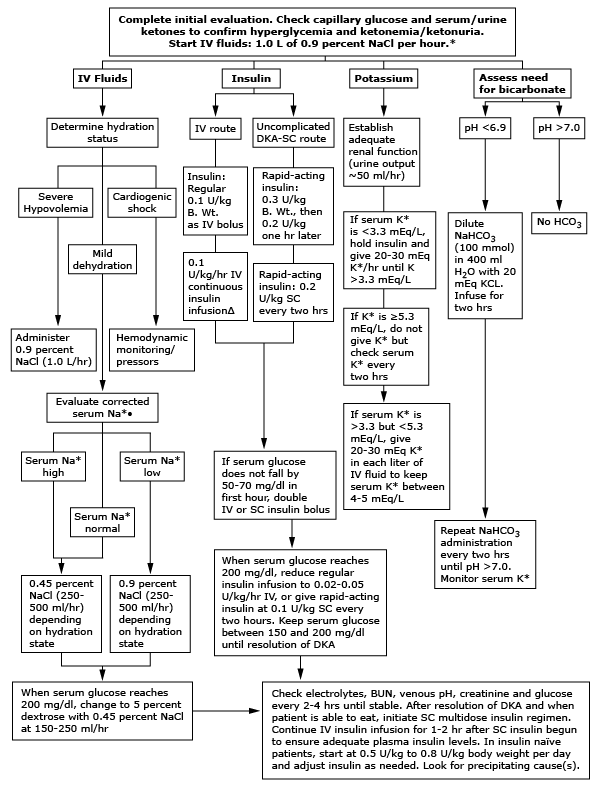Diabetic ketoacidosis
Background
- Hyperglycemia
- Leads to osmotic diuresis
- Loss of fluid, Na, Cl, K, Phos, Ca, Mg
- Leads to osmotic diuresis
- Acidosis
- Due to lipolysis / accumulation of of ketoacids (represented by anion gap showing conjugate bases)
- Compensatory respiratory alkalosis
- Breakdown of adipose > prostaglandin I2, E2
- Prostaglandins + acidosis = vasodilation
- Prostaglandins cause N/V/abd pain
- Dehydration
- Causes Renin system activation
- K and ketoanion loss (in exchange for chloride)
- Worsens metabolic acidosis
- K and ketoanion loss (in exchange for chloride)
- Causes Renin system activation
Causes
- Insulin non-compliance
- Infection
- Cardiac Ischemia
- Intra-abd process
- Meds
- Steroids, antipsychotics, thiazides
- ETOH Abuse
- Drug abuse
- Pregnancy
- Hyperthyroidism
- GI Hemorrhage
Workup
- CBC
- Chem 10
- UA
- Serum ketones: Beta-hydroxybutrate, acetoacetate
- hCG
- ECG
- VBG (often dose not change management unless suspect inadequate respiratory compensation)
- Venous pH ~ 0.03 lower than arterial pH
- Verify that respiratory compensation is as expected
- CXR
Diagnosis
- Diagnosis = BS >250, AG >10, bicarb <15, pH <7.3, mod ketones
- BS may be lower if impaired gluconeogenesis (liver failure)
- Bicarb may be normal if concurrent alkalosis (e.g. vomiting)
- In this case an elevated gap may be the only clue
- Severity
- Mild (ketosis): gap <12
- Mod: gap 12-18
- Severe: gap >18
Treatment
- Volume then potassium then insulin
Labs/Monitoring
- Glucose check Q1hr
- Chem 10 Q4hr (initially Q2hr)
- Check pH prn based on clinical status (eval respiratory compensation)
- Check appropriateness of insulin dose Q1hr (see below)
- Corrected Na:
- Add 1.6 for each glucose of 100 >100
Fluids
- Most pts 3-6L depleted
- If severe hypovolemia: 1L NS/hr for up to 3 hr
- If mild dehydration then evaluate corrected Na+
- If Normal Na or Hypernatremic: 1/2NS @ 250-500ml/hr
- If Hyponatremic: NS @ 250-500ml/hr
- When BS < 250 switch to D51/2NS@ 150-200 ml/hr(+/- KCl)
- Bolus NS as needed for unstable VS
Insulin
- Check K prior to insulin Tx!
- If K < 3.3 do not administer insulin
- IV Route
- IV gtt 0.1 U/kg/hr
- Bolus dose unnecessary
- Expect BS fall by 50-100 mg/dL per hr
- If BS, pH, AG not improving after adequate hydration and UOP, then double infusion rate Q1hr until achieved
- Refractoriness often due to infection
- When BS <200, reduce to 0.02-0.05 U/kg/hr IV OR give subQ 0.1 U/kg q2hr
- Maintain BS between 150 and 200 until resolution of DKA
- Continue IV infusion for 1-2 hr after SC insulin tx is begun
- IV gtt 0.1 U/kg/hr
- SubQ route (appropriate only for mild DKA)
- Insulin lispro or aspart 0.3 U/kg initially
- 0.2 U/kg one hr later
- 0.2 U/kg q2hr thereafter
- 0.2 U/kg one hr later
- If BS does not decrease by 50-100/hr then double dose qhr until achieved
- Insulin lispro or aspart 0.3 U/kg initially
- Pitfalls
- Do not stop insulin infusion until AG normalized AND bicarb normalized
- Excess Cl from NS bolus' artificially raises serum Cl
Potassium
- Ensure adequate urine output before giving K
- Prevent Hypokalemia
- >5.5: don't give, but recheck q2hr
- 3.3-5.5: give 30 meq/hr in each liter bag
- 1/2NS is preferred b/c adding 30meq to NS = hypertonic soln
- <3.3: hold insulin and give 30 meq/hr until K >3.3
Bicarb
- Consider for pH <6.9 AND:
- Decreased contractility
- Hypotension
- Severe Hyperkalemia
- Coma
- 100 meq NaHCO3 in 400mL H2O @ 200 mL/hr
- Dose as needed until pH > 7.00
Phosphate
- Hypophosphatemia following insulin tx usually asymptomatic
- Consider repletion (KPO4 20-30 meq/L)if:
- Phosphate <1.0
- Cardiac dysfunction
- Respiratory dysfunction
- Evidence of hemolysis or rhabdo
DKA Refractory to Treatment
Ketoacidosis/ AG persists & BG 70 to 150 mg/dL:
- Start D10W or D10NS @ 150 - 250 mL/h and/or consider reducing insulin rate by 1/2.
- Keep Serum glucose between 150 – 200 mg/dL
Ketoacidosis/ AG persists & BG < 70 mg/dL:
- Hold insulin X 15 min and Bolus 1 AMP D50 IVP
- Recheck FS BG if < 70, retreat w/ 1 AMP D50 IVP and repeat FS BG
- Once FS BG > 70 mg/dL, restart Insulin @ 1⁄2 prior infusion rate
- Start D10W or D10NS (If volume depleted)@ 150 - 250 mL/h
- Keep Serum glucose between 150 –200 mg/dL
- If cannot maintain glucose > 150 mg/dL despite D10 and diet then titrate insulin down to a minimum of 0.5 unit/hr
Complications
- Cerebral Edema
- Almost all affected pts are <20yr
- Associated with initial bicarb level; not rate of glucose drop
- Premonitory symptoms:
- Headache
- Incontinence
- Mental Status Change / Seizure
- Treatment
- Mannitol IV 1-2gm/kg OR
- 3% NS 5-10mL/kg over 30min
- Noncardiogenic pulmonary edema
Sliding Scale
- 200-250 = 4u sq
- 251-300 = 6
- 301-350 = 8
- 351-400 = 10
Treatment Algorithm
See Also
Source
- Tintinalli's
- UpToDate
- EBmedicine.net
Image: UpToDate



